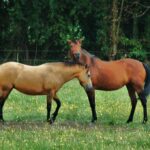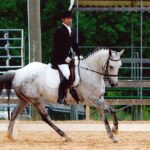The journey of training a horse to move with grace, balance, and responsiveness is both an art and a science. Whether you’re working with a young horse just starting under saddle or refining the gaits of a more experienced equine partner, developing smooth, consistent transitions between walk, trot, and canter requires patience, consistency, and understanding. A well-trained horse who moves comfortably through all three gaits not only provides a more enjoyable riding experience but also develops proper muscle tone and athleticism that contributes to their long-term soundness. This comprehensive guide will walk you through the process of developing these fundamental gaits, from establishing the basics to refining your horse’s movement for optimal performance and comfort.
Understanding Equine Movement Fundamentals

Before diving into training techniques, it’s essential to understand how horses naturally move through their gaits. The walk is a four-beat gait where each hoof strikes the ground individually in a regular rhythm. The trot is a two-beat diagonal gait where opposite legs move in pairs (left front/right hind, then right front/left hind), while the canter is a three-beat gait with a moment of suspension. Each horse has natural tendencies that affect how they move—some may have naturally fluid gaits while others might be stiffer or more challenging to balance. These individual differences stem from conformation, previous training experiences, and sometimes physical limitations that may require veterinary attention. Taking time to observe and understand your horse’s natural way of going provides crucial insight that will inform your training approach and help you set realistic goals for improvement.
Creating a Foundation of Trust and Respect

Successful gait training begins on the ground with a solid foundation of mutual trust and respect between you and your horse. Spend time doing groundwork exercises that establish you as a calm, confident leader and help your horse understand basic cues and expectations. These exercises might include leading exercises where your horse must match your pace, stopping when you stop, and moving forward when you do. Lunging and liberty work also help develop your communication system while allowing you to observe your horse’s natural movement patterns without the influence of a rider. A horse that trusts you will be more willing to try new things and respond positively to training challenges. This foundation is particularly crucial when working with young or sensitive horses who may become easily confused or anxious during the learning process.
Developing a Balanced Walk

The walk is the foundation for all other gaits and deserves careful attention during training. A quality walk should be energetic, purposeful, and demonstrate clear four-beat rhythm with good tracking of hind legs into front hoofprints. Begin by focusing on straightness—your horse should move forward without leaning or drifting sideways, maintaining even weight distribution across all four legs. Use subtle half-halts and consistent leg pressure to encourage your horse to engage their hindquarters and step under themselves, creating a more animated and balanced movement. Practice transitions within the walk, moving between a working walk, free walk on a long rein, and collected walk as your horse progresses. These variations help develop the horse’s responsiveness to your aids while building the appropriate muscles needed for balanced movement in all gaits.
Mastering Smooth Trot Transitions

Transitions into and out of the trot are critical moments that reveal your horse’s balance and understanding of your aids. When asking for an upward transition from walk to trot, prepare your horse with a half-halt to create momentary collection, then apply clear leg aids while maintaining light, consistent contact with the reins. The transition should feel deliberate rather than explosive, with your horse stepping smoothly into trot rather than lurching forward. For downward transitions, focus on maintaining the energy while slowing the rhythm—this prevents your horse from simply falling into a walk and teaches them to stay engaged through the transition. Practice these transitions frequently, but in short segments to prevent fatigue or resistance. A useful exercise is to establish a pattern of walk-trot transitions at specific points in your riding area, which helps your horse anticipate and prepare for smooth changes of gait.
Developing Rhythm and Impulsion in the Trot

A smooth, balanced trot demonstrates consistent two-beat rhythm and appropriate impulsion that propels the horse forward with energy. To improve your horse’s trot quality, focus first on establishing a steady rhythm that neither rushes nor drags. Use your seat and posting rhythm to influence your horse’s tempo, slowing your posting to encourage a more measured stride or quickening slightly to prevent sluggishness. Incorporate large circles, serpentines, and gentle changes of direction to help your horse develop balance without losing rhythm. As coordination improves, introduce trot poles set at appropriate distances for your horse’s stride length, which naturally encourages lifting of the back and engagement of core muscles. Working in varied terrain, such as gentle uphills, can also strengthen your horse’s hindquarters and improve their ability to carry themselves properly in the trot.
Introducing the Canter with Confidence

The transition to canter often presents the greatest challenge for both horse and rider, but approaching it methodically builds confidence and coordination. Begin canter work only after your horse demonstrates reliable responsiveness at walk and trot and shows good balance on circles and through basic changes of direction. Request the canter from a balanced, energetic trot on a circle, using clear aids: outside leg slightly behind the girth, inside leg at the girth, and a supporting inside rein that allows forward movement while maintaining bend. Your weight should shift slightly to the inside seat bone while maintaining an upright position. If your horse struggles with picking up the correct lead, try positioning their shoulders slightly to the inside before asking for the transition, which naturally sets them up for the proper lead. Limit initial canter work to short intervals on circles or gentle curves, gradually increasing duration as strength and confidence develop.
Addressing Common Canter Problems

Even well-trained horses can encounter challenges with canter work that require specific remedial approaches. Rush cantering, where the horse accelerates uncontrollably, often indicates tension or balance issues and can be addressed by practicing many canter-trot-canter transitions that teach the horse to maintain a consistent rhythm. Cross-cantering or disunited cantering (where the horse canters on one lead in front and another behind) typically stems from lack of strength or coordination and benefits from gymnastic exercises like cavaletti work and hillwork to develop core muscles. Some horses struggle with consistent canter leads, particularly if they have a stiffer side; addressing this requires focused flatwork that improves overall lateral suppleness. For horses that buck or kick out during transitions, rule out physical discomfort with saddle fit checks and veterinary examination, then use groundwork and lunging to establish the canter pattern before attempting under saddle.
Refining Transitions Between All Three Gaits

The hallmark of a well-trained horse is the ability to move smoothly between gaits while maintaining balance, engagement, and responsiveness. To develop seamless transitions, practice systematic exercises that challenge your horse in predictable patterns, such as walk-trot-canter-trot-walk sequences on a 20-meter circle. Focus on the quality of each transition rather than quantity, rewarding moments of particular balance and responsiveness with praise and brief rest periods. Strive for transitions that flow naturally without abrupt changes in the horse’s frame or balance—the horse should maintain connection through the bridle and engagement of the hindquarters throughout each change of gait. As your horse progresses, practice transitions at different points in your riding area and eventually on different lines, including straight lines and shallow curves that require more balance than circles.
Using Ground Poles and Cavaletti for Gait Improvement

Ground poles and cavaletti are invaluable tools for developing rhythm, coordination, and engagement across all gaits. For walk work, set 4-5 poles approximately 2.5-3 feet apart and guide your horse through them, focusing on maintaining an even rhythm and encouraging them to lift their feet deliberately rather than shuffling. At the trot, poles spaced at 4-5 feet intervals encourage the horse to reach under their body with their hind legs, activating core muscles and promoting balance. Cavaletti (raised poles) can be arranged on curves or straight lines to further challenge coordination and strengthen the muscles needed for collection and extension. These exercises are particularly effective for horses that tend to be on the forehand or struggle with rhythm issues. Start with simple arrangements and gradually increase complexity as your horse gains confidence and ability, always adjusting spacing to suit your individual horse’s natural stride length.
Implementing Lateral Work for Collection and Extension

Lateral movements are sophisticated training tools that develop the horse’s ability to move with greater collection and extension through all gaits. Beginning with simple leg yielding at the walk, teach your horse to move sideways while maintaining forward momentum, which improves responsiveness to leg aids and loosens rigid movement patterns. Progress to shoulder-in work, where the horse travels with their shoulders brought slightly to the inside while maintaining bend and forward movement—this exercise particularly strengthens the inside hind leg and promotes collection. As your horse masters these basics, introduce haunches-in (travers) and eventually half-pass work that further enhances lateral suppleness and engagement. These exercises, practiced consistently at walk before attempting at trot and eventually canter, create a horse that can shift their weight more effectively between hindquarters and forehand, resulting in smoother transitions and greater adjustability within each gait.
Recognizing and Working with Your Horse’s Natural Tendencies

Every horse brings unique physical attributes and temperamental tendencies to the training process that influence how they move through different gaits. Some horses naturally carry themselves in a more uphill balance that facilitates collection, while others may be built downhill and require more focused work to develop hindquarter strength and engagement. Similarly, hot, energetic horses might require exercises that promote relaxation and rhythm, while more phlegmatic types benefit from work that builds enthusiasm and responsiveness. Take time to analyze your horse’s conformation, observing aspects like shoulder angle, pastern length, and back-to-hindquarter ratio, which all impact movement quality. Adapt your training approach to work with rather than against these natural tendencies—this might mean more frequent but shorter sessions for sensitive horses, or more varied, stimulating exercises for those that tend toward laziness.
Using Ring Figures to Improve Balance and Flexibility

Systematic work with traditional riding figures develops the strength and coordination needed for smooth gaits and transitions. Start with large circles (20 meters) in both directions, focusing on maintaining consistent bend throughout the horse’s body and even rhythm around the entire circle. As coordination improves, introduce figure eights that require the horse to change bend through their body while maintaining gait and rhythm. Serpentines across the length or width of your riding area further challenge your horse to maintain balance through repeated changes of direction. For more advanced horses, incorporate spirals where you gradually decrease and then increase the size of your circle, which develops greater collection and extension capabilities. These figures should be practiced at walk initially, then at trot, and finally at canter as your horse demonstrates sufficient balance and understanding at each gait.
Troubleshooting Common Training Challenges

Even with careful, methodical training, most horses will encounter stumbling blocks that require creative problem-solving. Horses that consistently rush or become heavy on the forehand often benefit from transitions within gaits (slower trot to more forward trot) rather than between gaits, which builds self-carriage without overwhelming them. For horses that become tense and hollow their back during canter work, incorporate relaxing stretches at walk between short canter segments and consider whether your own tension might be contributing to the problem. Horses that struggle with maintaining straightness typically have a stronger, more developed side; address this through targeted exercises like shoulder-in and leg-yield that strengthen the weaker side. When horses refuse upward transitions or become balky, rule out pain issues first, then simplify your requests by returning to basics like forward movement on the lunge line before progressing to under-saddle work. Remember that regression in training often indicates that you’ve advanced too quickly—don’t hesitate to take a step back when necessary.
Incorporating Variety to Maintain Enthusiasm

A balanced training program includes sufficient variety to keep both horse and rider engaged and enthusiastic about their work. Alternate arena schooling with trail rides where your horse can apply their gait training in different environments, encountering natural elevation changes that build strength and confidence. Incorporate play elements like trotting over small jumps or poles, or set up simple obstacle courses that challenge your horse to navigate different features while maintaining gait and responsiveness. Working in different locations—moving from an indoor arena to an outdoor ring, or visiting a new facility occasionally—prevents your horse from becoming arena-sour and tests their ability to maintain focus in different surroundings. Cross-training with activities like hill work, water crossing, or even basic dressage patterns adds mental stimulation while developing different muscle groups that support overall balance and movement quality.
Developing a Progressive Training Schedule

Consistent progress requires thoughtful planning that balances challenge with consolidation of skills. Create a weekly schedule that incorporates focused flatwork sessions interspersed with more relaxed hacking or trail riding, allowing mental and physical recovery between intensive training days. A typical progression might include a Monday focus on walk-trot transitions and rhythm, Tuesday trail ride with natural terrain variations, Wednesday rest or light groundwork, Thursday focus on canter development, Friday pole work for coordination, and weekend trail rides or varied activities. Adjust your expectations based on your horse’s age, fitness level, and previous training—young horses typically benefit from shorter, more frequent sessions with plenty of variation, while more experienced horses can handle longer, more focused work. Track your progress with written notes or video recordings, which allow you to recognize subtle improvements that might otherwise go unnoticed and help you refine your training approach based on what’s working best for your individual horse.
Conclusion

The journey to developing smooth, balanced gaits in your horse is one of the most rewarding aspects of horsemanship. Through patient, progressive training that respects your horse’s individual nature while systematically building strength and understanding, you’ll develop a partnership characterized by harmony and mutual respect. Remember that true quality of movement comes not from forcing your horse into positions, but from building the physical capability and mental willingness to move with engagement and self-carriage. Celebrate small victories along the way, and don’t hesitate to seek guidance from experienced trainers when you encounter persistent challenges. With time and consistent work, your horse will develop the strength, balance, and responsiveness to move through all three gaits with the kind of effortless grace that makes riding a true joy.







